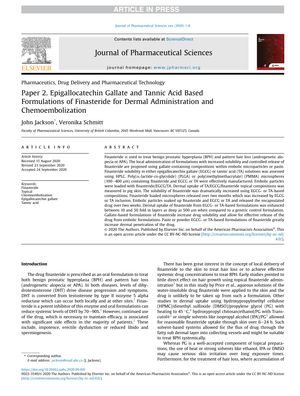TLDR Topical finasteride with EGCG or TA improves drug release and dermal uptake, potentially treating hair loss effectively.
The University of British Columbia has developed topical formulations of finasteride for dermal administration and chemoembolization using epigallocatechin gallate and tannic acid. The study found that adding EGCG or TA to finasteride formulations improved drug release and dermal uptake compared to a generic control, with EGCG- or TA-based formulations increasing dermal penetration of the drug. The study investigated the use of finasteride for hair loss and BPH treatment through topical application and found that solvent-based systems were more effective for systemic drug delivery than aqueous solutions. The paper proposes that using EGCG and tannic acid formulations could be a viable treatment for hair loss by inhibiting 5-alpha reductase and penetrating the skin effectively. Further research is needed to determine their safety and effectiveness in humans.
 14 citations
,
January 2020 in “Biomaterials Science”
14 citations
,
January 2020 in “Biomaterials Science” Created microspheres show potential for safe and effective use in prostate artery embolization.
 30 citations
,
March 2016 in “European Journal of Pharmaceutical Sciences”
30 citations
,
March 2016 in “European Journal of Pharmaceutical Sciences” Optimized film improves finasteride skin absorption and treatment efficiency.
 23 citations
,
June 2014 in “Journal of Pharmaceutical Sciences”
23 citations
,
June 2014 in “Journal of Pharmaceutical Sciences” Finasteride cream helps hair growth with less side effects.
 13 citations
,
August 2013 in “Journal of pharmaceutical sciences”
13 citations
,
August 2013 in “Journal of pharmaceutical sciences” Researchers created a skin patch that delivers two drugs for treating enlarged prostate, which may improve patient use and dosage control.
219 citations
,
October 2009 in “Steroids” 5α-reductase inhibitors, like Finasteride and Dutasteride, help manage benign prostatic hyperplasia.
 12 citations
,
August 2000 in “Fertility and Sterility”
12 citations
,
August 2000 in “Fertility and Sterility” Topical finasteride doesn't reduce DHT levels, hinting at an endocrine role in hair loss.
 16 citations
,
October 2023 in “Molecular cancer”
16 citations
,
October 2023 in “Molecular cancer” New treatments like nanotechnology show promise in improving skin cancer therapy.
9 citations
,
June 2022 in “Plants” Shallot extract may help with hair growth and treating hair loss.
 6 citations
,
October 2017
6 citations
,
October 2017 Indian Gooseberry has potential for cancer prevention and treatment and promotes hair growth.
 November 2024 in “Journal of Clinical Medicine”
November 2024 in “Journal of Clinical Medicine” The treatment improved hair thickness, shine, and reduced hair loss effectively.
 12 citations
,
September 2014 in “Journal of Food Science and Nutrition”
12 citations
,
September 2014 in “Journal of Food Science and Nutrition” Platycarya strobilacea extract is a strong antioxidant that can grow hair better than minoxidil.









